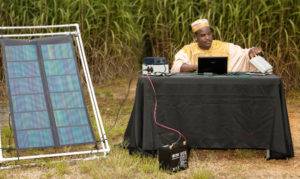How you plan to use your solar power system affects what you need to buy, especially when it comes to the solar panels. Picture exactly how you’re going to use your system before you buy.
Most small commercially made solar power systems are designed for temporary use such as backpacking, “RV-ing,” or camping. A good example is the Goal-Zero Sherpa 100 power pack. In this scenario:
- The power bank is used for a few days or weeks at a time, and then sits in storage until the next trip.
- The solar panels are laid outdoors on the ground right next to the power bank, possibly inside a tent or vehicle for protection. The power cord on the solar panel is only a few feet long.
- The solar panels are brought indoors at night or when it rains, and don’t need to be durable enough to survive years of harsh exposure.
- Light weight is worth paying a premium for.
- The power bank is brought indoors in the evening and used to recharge the battery in a phone, camera or tablet.
- The device is not field repairable, but disposable after a couple years.
If this is the sort of usage scenario you anticipate, A Sherpa 100 or Voltaic V72 battery system will serve you well. A folding canvas-covered solar panel like our Bioenno 28 W or similar products sold on amazon.com will provide lightweight power that isn’t too expensive, or you can get the deluxe Global Solar folding 30 W panel which will last a lot longer and is even lighter and more rugged. Our Villager and Half-Pint power systems can also be used like this if you pair them with a portable panel and short cord.
In contrast, some field workers have a need for a more permanent power system that can be easily transported to a very remote location where it is permanently installed. Their equipment choice is driven by different trade-offs.
- The equipment is heavily cycled on a continuous basis, e.g. they use it every day for years at a time.
- The solar panels are permanently mounted outdoors and must survive the constant exposure to the weather.
- A long, heavy, UV-resistant power cable must be used to connect solar panels outdoors to the power bank which is located indoors.
- Possibly the user’s equipment is hooked up to the power bank and charging during the day while the power bank is also receiving power from the solar panels. (The power bank is discharging at the same time as it is charging.)
- Though weight is still important, low cost and ruggedness are more important.
- Long term survivability, extended battery life and field replaceable components mean lower cost for the users.
Our Villager and Half-Pint PV power systems are designed for this scenario with LiFePO4 batteries that are rated for 2000+ recharge cycles vs. hundreds of recharges for “normal” lithium batteries. The batteries and other components can be replaced by a field technician for much lower long-term costs. We offer a variety of solar panel options, including mounting kits to fit your budget and usage scenario. We can help you choose and make sure you have all the parts you need if you email us.

 GTIS Power and Communications Systems
GTIS Power and Communications Systems
